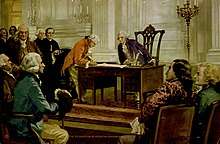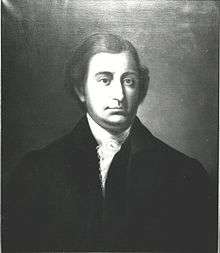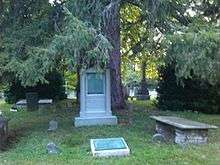Edmund Randolph
Edmund Jennings Randolph (August 10, 1753 – September 12, 1813) was an American attorney and politician. He was the seventh Governor of Virginia, and as a delegate from Virginia, attended the Constitutional Convention, helping to create a national constitution. He was the second Secretary of State, and the first United States Attorney General during George Washington's presidency.
Edmund Randolph | |
|---|---|
_by_an_unidentified_artist.png) | |
| 2nd United States Secretary of State | |
| In office January 2, 1794 – August 20, 1795 | |
| President | George Washington |
| Preceded by | Thomas Jefferson |
| Succeeded by | Timothy Pickering |
| 1st United States Attorney General | |
| In office September 26, 1789 – January 26, 1794 | |
| President | George Washington |
| Preceded by | Position established |
| Succeeded by | William Bradford |
| 7th Governor of Virginia | |
| In office December 1, 1786 – December 1, 1788 | |
| Preceded by | Patrick Henry |
| Succeeded by | Beverley Randolph |
| Personal details | |
| Born | Edmund Jennings Randolph August 10, 1753 Williamsburg, Virginia, British America |
| Died | September 12, 1813 (aged 60) Millwood, Virginia, U.S. |
| Political party | Federalist |
| Spouse(s) | Elizabeth Nicholas |
| Relatives | John Randolph (Father) |
| Education | College of William and Mary (BA) |
| Signature | |
Life and career
Randolph was born on August 10, 1753 to the influential Randolph family in Williamsburg in the Colony of Virginia. He was educated at the College of William and Mary. After graduation he began reading law with his father John Randolph and uncle, Peyton Randolph. In 1775, with the start of the American Revolution, Randolph's father remained a Loyalist and returned to Britain; Edmund Randolph remained in America where he joined the Continental Army as an aide-de-camp to General George Washington.[1]
Upon the death of his uncle Peyton Randolph in October 1775, Randolph returned to Virginia to act as executor of the estate, and while there was elected as a representative to the Fourth Virginia Convention. He was later mayor of Williamsburg, and then Attorney general of Virginia, a post he held until 1786.[1] He was married on August 29, 1776 to Elizabeth Nicholas (daughter of Robert C. Nicholas), and had a total of six children, including Peyton Randolph, Governor of Virginia from 1811 to 1812.[2]
Political career
Randolph was selected as one of eleven delegates to represent Virginia at the Continental Congress in 1779, and served as a delegate through 1782. During this period he also remained in private law practice, handling numerous legal issues for George Washington among others.[1]
Randolph was elected Governor of Virginia in 1786, that same year leading a delegation to the Annapolis Convention. He had taken on the young John Marshall as a student and then law partner, and transferred his lucrative law practice to Marshall when he became governor in 1786, since Virginia law forbade executive officers from private practice in its courts.[3]
Constitutional Convention

The following year, as a delegate from Virginia to the Constitutional Convention, at age 34 Randolph introduced the Virginia Plan as an outline for a new national government.[5] He argued against importation of slaves and in favor of a strong central government, advocating a plan for three chief executives from various parts of the country. The Virginia Plan also proposed a bicameral legislature, both houses of which comprising delegates chosen based on state population. Randolph additionally proposed, and was supported by unanimous approval by the Convention's delegates, "that a Nationally Judiciary be established" (Article III of the constitution established the federal court system).[6] The Articles of Confederation lacked a national court system for the United States.
Randolph was also a member of the "Committee of Detail" which was tasked with converting the Virginia Plan's fifteen resolutions into a first draft of the Constitution.
Randolph ultimately refused to sign the final document, one of only three members who remained in the Constitutional Convention yet refused to sign (together with fellow Virginian George Mason and Elbridge Gerry of Massachusetts).[7] Randolph thought the final document lacked sufficient checks and balances, and published an account of his objections in October 1787. Randolph had several objections to the Convention's proposal. He thought the federal judiciary would pose a threat to state courts, and he thought the Senate was too powerful and Congress's power too broad. He also objected to there being no provision for a second convention to act after the present instrument had been referred to the states.[1]
Role in ratification
Virginia Convention
Randolph nevertheless reversed his position at the Virginia Ratifying Convention in 1788. He chaired that nearly equally divided convention, and Mason (as one of the opposition leaders, along with Patrick Henry) greatly resented Randolph's change of position. Mason and other opponents demanded amendments prior to ratification. Randolph noted that he had seen several responses to the insistence that amendments were necessary before ratification. Some thought the objection insubstantial because the Constitution provided a process for amendment. In common with other advocates of amending the Constitution prior to ratification, Randolph insisted that it would be easier to amend the Constitution before ratifying it, when a majority might do so, than to ratify an imperfect Constitution and then assemble the votes of three-fourths of the states. He did not think it desirable that the people should become accustomed to altering their constitution with any regularity once it was adopted.
The Governor had written "If after our best efforts for amendments, they cannot be obtained, I will adopt the constitution as it is." Ultimately, Randolph said he voted for ratification of the Constitution because by June 2 eight other states had already done so, and he did not want to see Virginia left out of the new national government. Randolph believed that Virginia must choose between the stark alternatives of ratification and disunion. Randolph never doubted union's advantages.
In the Richmond Ratification Convention, it was Randolph who ultimately pointed the way to an understanding of ratification with which Virginia's leaders could be satisfied. He assured his fellow members of the Virginia political elite that the Constitution they were being asked to ratify in the summer of 1788 would have very limited significance—that what they would be entering was more a league of sovereign states than a consolidated union.
Randolph wrote that of the ten delegates whose views had been completely unknown, five had been swayed to vote for ratification by his gambit. In the end, Virginia's Federalists secured the Constitution's ratification by precisely five votes.

Washington's Cabinet
Washington rewarded Randolph for his support. Randolph was appointed as the first U.S. Attorney General in September 1789, maintaining precarious neutrality in the feud between Thomas Jefferson (of whom Randolph was a second cousin) and Alexander Hamilton. In President Washington's cabinet, as in the ratification dispute of 1787–1788, Randolph tried to bring people together, rather than jumping to hasty conclusions and ignoring the potential costs in pursuit of self-righteous ideological purity. He continued to make important contributions to the structure of the new nation and to its relationship with the states.[1]
When Jefferson resigned as Secretary of State in 1793, Randolph succeeded him to the position. The major diplomatic initiative of his term was the Jay Treaty with Britain in 1794, but it was Hamilton who devised the plan and wrote the instructions, leaving Randolph the nominal role of signing the papers. Randolph was hostile to the resulting treaty, and almost gained Washington's ear, but was overridden in the wake of the Fauchet scandal (see below). Near the end of his term as Secretary of State, negotiations for Pinckney's Treaty were finalized.
Romance and married life with Elizabeth Nicholas
Miss Nicholas was daughter of the Hon. Robert Carter Nicholas, State Treasurer. Randolph wrote to his children after his wife's death:
"We were both born in the city of Williamsburg, within twelve hours of each other; myself on the 10th of August 1753, and she on the 11th. My aunt Randolph, who saw each of us soon after our birth, facetiously foretold that we should be united in marriage-a circumstance which, improbable at the time from the dissensions of our families, seemed daily to grow into an impossibility from their increasing rancor. In childhood we were taught the elements of reading at the same school… she won me by the best of all graces, cheerfulness, good sense, and benevolence. I do not recollect that I reflected much upon that range of qualities, which I afterwards found to be constituents of nuptial happiness; but Providence seemed to be kinder to me than my most deliberate judgment could have been… I desired nothing more than that she should sincerely persuade herself that she would be happy with me."[8]
On August 29, 1776, they were joined in wedlock. The relations between Randolph and his wife had always been true and tender. So free from friction had been the course of their united lives that his daughters could not forget the single instance of misunderstanding. Mrs. Randolph having related some incident, her husband hastily exclaimed: "That is mere gossip." The lady repaired to her room, where she did not answer her husband's gentle knock. Randolph then said "Betsey, I have urgent business in town, but I shall not leave this house until permitted to apologize to you."[9] The door opened and the unprecedented scene ends.
On March 6, 1810 came a blow from which Randolph could not recover; his wife died. After Mrs. Randolph's burial the heart-broken husband wrote some account of her, and of their married life, which was addressed to his children as "the best witnesses of the truth of the brief history."[9]
In part of this account Randolph wrote, "My eyes are every moment beholding so many objects with which she was associated; I sometimes catch a sound which deludes me so much with the similitude of her voice; I carry about my heart and hold for a daily visit so many of her precious relics; and, above all, my present situation is so greatly contrasted by its vacancy, regrets, and anguish, with the purest and unchequered bliss, so far as it depended on her, for many years of varying fortune, that I have vowed at her grave daily to maintain with her a mental intercourse."[9]
Resignation
A scandal involving an intercepted French message led to Randolph's resignation as Secretary of State in August 1795. Randolph had been tasked with keeping up friendly relations with France.[1] The British Navy had intercepted correspondence from the French minister, Joseph Fauchet, to his superiors and turned it over to Washington. Washington was dismayed that the letters reflected contempt for the United States and that Randolph was primarily responsible. The letters implied that Randolph had exposed the inner debates in the cabinet to the French and told them that the Administration was hostile to France. At the very least, Elkins and McKitrick conclude, there "was something here profoundly disreputable to the government's good faith and character." Washington immediately overruled Randolph's negative advice regarding the Jay Treaty. A few days later Washington, in the presence of the entire cabinet, handed the minister's letter to Randolph and demanded he explain it. Randolph was speechless and immediately resigned. Chernow and Elkins[10][11] conclude that Randolph was not bribed by the French but "was rather a pitiable figure, possessed of some talents and surprisingly little malice, but subject to self-absorbed silliness and lapses of good sense." However, Randolph's own published Vindication illustrates his concerns regarding both public and private perceptions of his character, concerns which held great value in the 18th century. In the event, Randolph secured a published retraction from Fauchet.[1]
After his resignation, Randolph was held personally responsible for the loss of a large sum of money during his administration of the state department. He was eventually adjudged to owe the government more than $49,000, which he paid.[1]
Later years

After leaving the federal cabinet Randolph returned to Virginia to practice law, where he was a leader of the state bar.[1] His most famous case was defending Aaron Burr at his trial for treason in 1807.
Death and legacy
Randolph lived his final years as a guest of his friend Nathaniel Burwell at Carter Hall, near Millwood, Virginia, in Clarke County. He suffered from paralysis in his final years and died, aged 60, on September 12, 1813. He is buried nearby at the Burwell family cemetery adjacent to "Old Chapel".
Randolph County, West Virginia was formed in 1787 and named in Governor Randolph's honor.[12] Randolph County, Illinois was as well, because Randolph was Virginia's governor at the time it ceded what was then sometimes called Illinois County, Virginia (a title disputed by Pennsylvania, among others) to the new federal Government, which created the Northwest Territory. That Randolph county's motto is "where Illinois began," because it was among the first two settled counties in that territory, and contains Kaskaskia, which was first seat of Illinois County, later became the Illinois territory's capital and ultimately the state's first capital.
The "Edmund J. Randolph Award" is the highest award given by the United States Department of Justice to persons who make "outstanding contributions to the accomplishments of the Department's mission."[13]
Sources
- Chisholm, Hugh, ed. (1911). . Encyclopædia Britannica. 22 (11th ed.). Cambridge University Press. p. 886.
- "Founding Fathers: Virginia". FindLaw Constitutional Law Center. 2008. Retrieved November 14, 2008.
- R. Kent Newmyer, John Marshall and the Heroic Age of the Supreme Court (Louisiana State University Press 2001) p. 79
- Robinson, Raymond H. "The Marketing of an Icon". George Washington: American Symbol. p. 117.
Figure 56 John Henry Hintermeister (American 1869-1945) Signing of the Constitution, 1925...Alternatively labeled Title to Freedom and the Foundation of American Government...".
- "Delegates to the Constitutional Convention: Virginia". University of Missouri–Kansas City. Retrieved June 11, 2011.
- Chemerinsky, Erwin (2007). Federal Jurisdiction (5th ed.). New York: Aspen Publishers. ISBN 978-0-7355-6407-7. LCCN 2007021049.
- Stewart 2007, p. 241.
- Conway, Moncure Daniel (1888). Omitted Chapters of History Disclosed in the Live and Papers of Edmund Randolph. G.P. Putnam's Sons The Knickerbocker Press. p. 37.
- Conway, Moncure Daniel (1888). Omitted Chapters of History Disclosed in the Life and Papers of Edmund Randolph. G.P. Putnam's Sons The Knickerbocker Press. pp. 388–90.
- Chernow, Ron (2010). Washington: A Life. New York: Penguin Press. pp. 731–734. ISBN 978-1-59420-266-7. LCCN 2010019154.
- Elkins, Stanley M.; Eric McKitrick (1993). The age of federalism. New York: Oxford University Press. pp. 425–426. ISBN 0-19-506890-4. LCCN 92033660.
- "Randolph County | County Facts". West Virginia Division of Culture and History. Archived from the original on October 29, 2013. Retrieved November 26, 2014.
- "Director Samuels Receives DOJ's Highest Award". Federal Bureau of Prisons. United States Department of Justice. December 16, 2015. Retrieved December 22, 2017.
The Award, named for the first Attorney General of the United States, appointed by President George Washington, recognizes outstanding contributions to the accomplishments of the Department's mission.
- Conway, Moncure D. Omitted Chapters of History: Disclosed in the Life and Papers of Edmund Randolph. Vol. 2. New York: G.P. Putnam's Sons, 1888. Print.
- Gutzman, Kevin R.C. "Edmund Randolph and Virginia Constitutionalism." The Review of Politics 66.3 (2004): 469–497. JSTOR. Web. February 5, 2015.
- Maier, Pauline. Ratification: The People Debate the Constitution, 1787–1788. New York: Simon & Schuster, 2010. Print.
- Stewart, David O. (2007), The Summer of 1787, New York: Simon & Schuster, ISBN 978-0-7432-8692-3
Further reading
- Reardon, John J. (1975). Edmund Randolph: a biography. Macmillan. ISBN 978-0026012003. Retrieved May 25, 2011.
Edmund Randolph.
- Randolph, Edmund (1855) [1795]. A Vindication of Edmund Randolph (new ed.). Richmond: Charles H. Wynne, printer. Retrieved May 25, 2011.
Edmund Randolph.
written by himself, with a preface by P.V. Daniel, Jr. - Randolph, Edmund (1795). Vindication of Mr. Randolph's resignation. Philadelphia: Samuel Harrison Smith. Retrieved May 25, 2011.
- An Impartial Statement of The Controversy, Respecting the Decision of the Late Committee of Canvassers, Containing, The Opinions of Edmund Randolph, Esq. Attorney General of The United States, and Several Other Eminent Law Characters. New York: Thomas Greenleaf. 1792. Retrieved January 29, 2020.
External links
| Wikisource has original works written by or about: Edmund Randolph |
| Wikimedia Commons has media related to Edmund Randolph. |
- United States Congress. "Edmund Randolph (id: R000043)". Biographical Directory of the United States Congress.
- A Guide to the Executive Papers of Governor Edmund Randolph, 1786–1788 at The Library of Virginia
| Political offices | ||
|---|---|---|
| Preceded by Patrick Henry |
Governor of Virginia 1786–1787 |
Succeeded by Beverley Randolph |
| Preceded by Thomas Jefferson |
United States Secretary of State 1794–1795 |
Succeeded by Timothy Pickering |
| Legal offices | ||
| New office | United States Attorney General 1789–1794 |
Succeeded by William Bradford |



